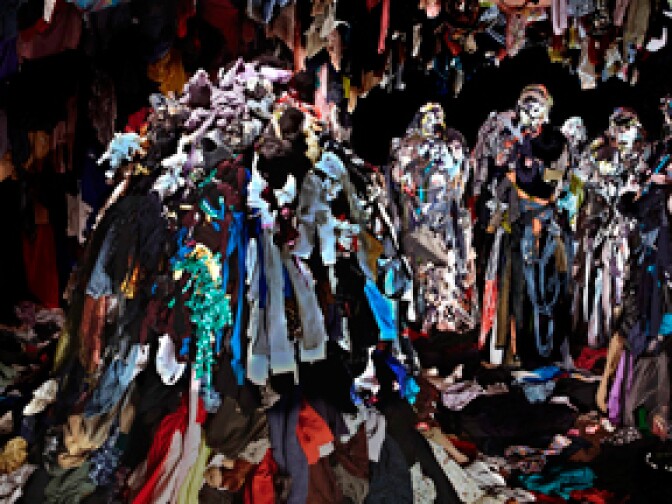With our free press under threat and federal funding for public media gone, your support matters more than ever. Help keep the LAist newsroom strong, become a monthly member or increase your support today.
Art exhibit at Pitzer College immerses visitors in a virtual sweatshop
A new art exhibit at the Pitzer College galleries in Claremont asks viewers to consider the clothing on their backs – and the labor that made it. “Worker” immerses people in the dim, claustrophobic world of garment sweatshops.
It’s not unusual for visitors to hesitate at the gallery’s entrance – unsure if it’s OK or even safe to venture inside. Layers of used T-shirts, blouses, jeans and sweaters carpet the floor, walls and ceiling. A hive of bees buzzes overhead.
L.A.–based artists James Gilbert and Jennifer Vanderpool lead the way through a long tunnel of garments. “When you first walk in there’s the sound of bees, and the buzzing kind of activity that happens. So we’re taking it down the hallway, and if you wanna move right in."
It opens into a large, windowless space filled with piles of discarded clothing. It took the artists, mostly working alone, weeks to assemble the installation.
Their work was inspired by the bleak garment factory environments found across the globe, and by their own mothers who once worked in textile factories. Recordings of the outside world – birds, bees, traffic – clash with the monotonous grind of industrial work.
“Machine sounds, sewing machines, city sounds that seem to be infinite that go on, sounds right there of someone walking," says Gilbert, "so it’s like someone is monitoring the space, there some clocks, dripping sounds from cave. All these things were recorded to kind of simulate the worst kind of environment you could work in.”
Another sound is heard. “Bus going by and a sewing machine," says Vanderpool. "The piece really desensitizes you without the light, and this constant sound and then there are figurative elements that are human scale and it creates a relationship. If you walk you’re confronted by these figures, and mounds of clothing.”
A group of faceless, motionless bodies, constructed by the artists, rise up from the floor – wrapped head to toe in ripped and knotted garments, like primordial mummies churned up from a swamp of clothing.
“They don’t really have exact identity," says Gilbert, "but their posture really identifies who they are. Some of them are hunched over, and we actually really wanted to have that characteristic like someone would have in a sweatshop working long hours hunched over a machine. My hands were swollen; Jen’s hands were swollen. You’re breathing in all this fabric. You kind of feel a little sick from breathing it. So you can image what someone that does this every day [goes through].”
“The biggest thing for me about this installation is the smell," says Ciara Ennis, curator of the Pitzer College Campus Galleries. "I walk in here and I immediately think of terrible, awful things that have happened.
“I smell used clothes that have been abandoned and thrown away because either people died or they had too much of something. It still has that nasty kind of used feeling. And this is a very melancholic, highly charged installation for me.”
One of the most unsettling things about the “Worker” exhibit is the absence of humanity. There are no human voices – or faces.
“Who is making the product?" says Gilbert. "Do they have a voice or are they anonymous? Do they have an identity?
“It’s not like a chummy environment that happens.”
“It’s not collegial," says Vanderpool. "It’s not friendly. It’s not inviting.”
“Keep-your-head-down kind of attitude," says Gilbert.
“Right," says Vanderpool, "and I think that the sculptures themselves convey the presence of the laborers.”
And, says Vanderpool, gallery visitors do the rest. “You as the viewer become the figure in the environment and the creator of that noise.”
After the “Worker” exhibit completes its run, the artists will donate the mounds of undamaged garments to charity. “Worker” will be on the job at Pitzer College’s Lenzer Gallery through next month.









